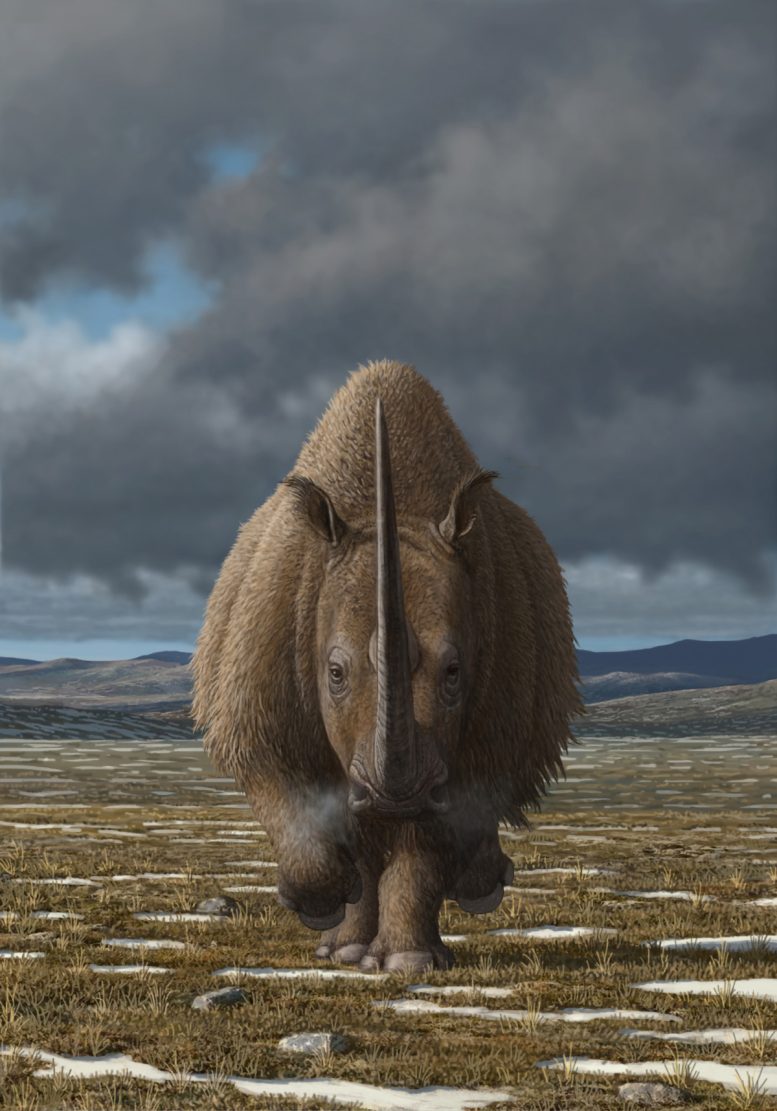
Woolly rhinoceroses were once widely distributed across northern and central Eurasia, before going extinct some 10,000 years ago. Credit: Mauricio Anton
Advanced computer modeling reveals that sustained human hunting contributed to the woolly rhinoceros’s extinction by blocking their migration to new habitats during post-Ice Age warming, highlighting the ongoing impact of human activity on large animal species.
Researchers found that persistent hunting by humans restricted the woolly rhinoceros from reaching preferred habitats as the Earth warmed after the Last Ice Age.
An international team of researchers, led by scientists from the University of Adelaide and University of Copenhagen, used computer modelling to make the discovery, shedding light on an aeons-old mystery.
“Using computer models, fossils and ancient DNA, we traced 52,000 years of population history of the woolly rhinoceros across Eurasia at a resolution not previously considered possible,” said lead author Associate Professor Damien Fordham, from the University of Adelaide’s Environment Institute. “This showed that from 30,000 years ago, a combination of cooling temperatures and low but sustained hunting by humans caused the woolly rhinoceros to contract its distribution southward, trapping it in a scattering of isolated and rapidly deteriorating habitats at the end of the Last Ice Age. As Earth thawed and temperatures rose, populations of woolly rhinoceros were unable to colonise important new habitats opening up in the north of Eurasia, causing them to destabilise and crash, bringing about their extinction.”
An iconic species of megafauna, the woolly rhinoceros had thick skin and long fur, and it once roamed the mammoth step of northern and central Eurasia, before its extinction around 10,000 years ago.
Contradictory Findings and Human Impact
This recent discovery, published in PNAS, contradicts previous research that found humans had no role in the extinction of the woolly rhinoceros – despite the animal co-occurring with humans for tens of thousands of years prior to its extinction.
“The demographic responses revealed by our analysis were at a much higher resolution to those captured in previous genetic studies,” said Professor Eline Lorenzen, from the University of Copenhagen’s Globe Institute. “This allowed us to pinpoint important interactions that woolly rhinoceroses had with humans and document how these changed through space and time. One of these largely overlooked interactions was persistent low levels of hunting by humans, probably for food.”
Humans pose a similar environmental threat today. Populations of large animals have been pushed into fragmented and suboptimal habitat ranges due to over hunting and human land-use change.
There were 61 species of large terrestrial herbivores – weighing more than one tonne – alive in the late Pleistocene, and only eight of these exist today. Five of those surviving species are rhinoceroses.
“Our findings reveal how climate change and human activities can lead to megafauna extinctions,” said Professor David Nogues-Bravo, from the University of Copenhagen, who was a co-author of this study. “This understanding is crucial for developing conservation strategies to protect currently threatened species, like vulnerable rhinos in Africa and Asia. By studying past extinctions, we can provide valuable lessons for safeguarding Earth’s remaining large animals.”
Reference: “52,000 years of woolly rhinoceros population dynamics reveal extinction mechanisms” by Damien A. Fordham, Stuart C. Brown, Elisabetta Canteri, Jeremy J. Austin, Mark V. Lomolino, Sean Haythorne, Edward Armstrong, Hervé Bocherens, Andrea Manica, Alba Rey-Iglesia, Carsten Rahbek, David Nogués-Bravo and Eline D. Lorenzen, 3 June 2024, Proceedings of the National Academy of Sciences.
DOI: 10.1073/pnas.2316419121









Could it not be possible that instead of it going extinct it actually evolved losing its wooly hair because of climate changes gwtting hotter thus becoming the Rhinocerous we have to this day? And is therefore not extinct but evolved to survive the changes in its enviroment like most living creatures due in extreme enviroment changes EVOLUTION MAKES MUCH MORE SENSE IN MY OPINION OF THIS SUBJECT Where did our rhinos today come from otherwise
No, the DNA the article discuss show these two rhinoceros were different species.
Evolution from common ancestors show how ancestors can speciate. “The woolly rhinoceros was the most recent species of the genus Coelodonta. The closest living relative of Coelodonta is the Sumatran rhinoceros, and the genus is also closely related to the extinct genus Stephanorhinus.”
The Sumatran rhinoceros in turn evolved from an ancestor of Javan and Indian rhinoceros. And they in turn share an ancestor with modern African rhinoceros. [Wikipedia]